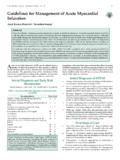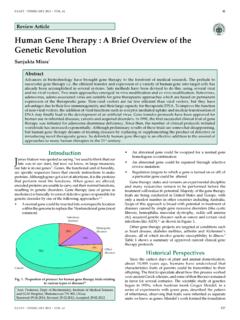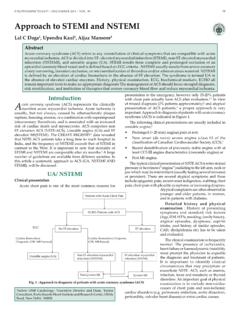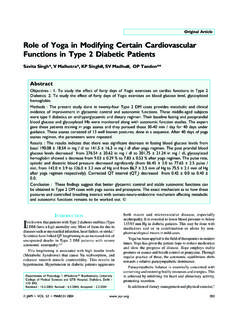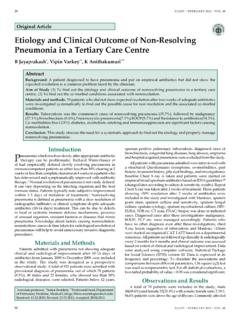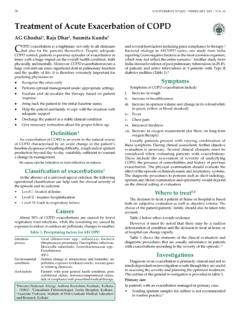Transcription of DRUG CORNER - japi.org
1 100 Journal of The Association of Physicians of India Vol. 65 February 2017 calcium and calcium Salts Abhijit Trailokya1, Ambrish Srivastava2, Milind Bhole3, Nitin Zalte3 1 Deputy General Manager, 2VP Medical, 3 Medical Advisor, Medical Department of Alkem laboratory, Mumbai, MaharashtraReceived: ; Accepted: CORNERA bstract calcium is the most abundant mineral in the body. Bones and teeth contain approx. 99% of calcium . calcium exists in both plant and animal foods. The best source of calcium is milk. Indian Council of Medical Research (ICMR) recommends 600-800 mg/day of calcium which increases to 1200 mg/day in pregnant and lactating mothers.
2 Inadequate calcium intake for longer duration is responsible for osteopenia and osteoporosis. Prevention and treatment of osteoporosis is frequently done with calcium supplementation. calcium deficiency can be treated with various calcium preparations, organic salts like tricalcium citrate, calcium lactate, calcium lactate gluconate, calcium gluconate and inorganic salts like calcium chloride, calcium carbonate and calcium phosphate. Appropriate calcium salt selection depends on calcium content, solubility, taste and bioavailability as well as cost of available preparations.
3 The most commonly available salt forms are calcium carbonate and calcium citrate. calcium Carbonate provides with 40% elemental calcium , better absorbed and well tolerated especially when taken with a meal. It is the most commonly used and least expensive calcium salt as cost is a consideration for many patients. calcium Citrate provides 21% of elemental calcium and better absorbed than calcium carbonate in patients with higher gastric pH. calcium lactate and calcium gluconate do not contain adequate amount of calcium hence not a choice for practical use.
4 Data available on hydroxyapatite as a calcium source is limited. calcium supplements are also derived from natural sources such as coral, dolomite and oyster shell. calcium from a coral has not been proven to be better than other calcium sources. Coral calcium products and Dolomite supplements may also contain unsafe amounts of lead along with other heavy metals. In clinical practice, to obtain optimal clinical outcomes, the dose of elemental calcium should not exceed 500 mg at one time. An adequate calcium intake through proper selection of calcium salt is one of the measures to ensure a healthy cheese) and amongst the plant foods are green leafy vegetables like amaranth, fenugreek leaves and broccoli.
5 Cereals like Ragi, nuts and seeds like almonds, pistachios and sesame seeds, fishes like salmon, sardines etc. are good sources of best source of calcium is milk. For Infants mother s milk is excellent score of calcium . The milk of cows, buffaloes and goats is rich in calcium . The calcium in milk is accompanied by a favourable proportion of phosphorus, hence, it is very well utilised in the products such as curd, paneer, mava, are decent sources of calcium . The millet ragi and seasame seeds (til) have a high concentration of calcium .
6 Green leafy vegetables are a good source of calcium , though only a part of the calcium from these is available to the body (Tables 1 and 2).Fresh as well as dried fish, especially small fresh fish, if the bones are also eaten, provide substantial quantities of calcium in the diet. Besides these, some spices such as cumin seeds (jeera), coriander seeds (dhaniya), contain enough calcium to make a contribution, if these are used frequently in sufficient quantity, in the Dietary Allowances of calcium for Indians2 Indian Council of Medical Research (ICMR) recommends more calcium is the most abundant mineral in the body.
7 Around 99% of total body calcium is stored in the bones and teeth, where it is essential for growth and maintenance. calcium in the bones amounts to 25 g at birth and builds up to about 1200 g in an adult. Around 1% is found in the blood, muscle, and cell fluids where it is needed for muscle contraction, heart contraction, blood clotting, secretion of hormones and enzymes, and sending messages through the nervous is present in both plant and animal foods. The richest source of calcium amongst animal foods are dairy products (milk, yoghurt 101 Journal of The Association of Physicians of India Vol.)
8 65 February 2017 Table 1: Bioavailability of calcium from selected foods1 Cauliflower, watercress, brussels sprouts, rutabaga,kale, mustard greens, broccoli, turnip greens 50%absorbedMilk, calcium -fortified soy milk, calcium -set tofu,cheese, yogurt, calcium fortified foods and beverages 30%Absorbed Almonds, sesame seeds, pinto beans, sweet potatoes 20%Absorbed Spinach, rhubarb, Swiss Chard 5%Absorbed Table 2: Food sources of calcium2 FoodsCalcium mg/ content for 100 edible portionMilk and Milk ProductsBuffalo s milk, cow s milk, goat s milk, curds (cow s)120-210 mg Cheese, khoa, skimmed milk powder and whole milk powder790 -1370 mg FishBacha, katla, mrigal, pran and rohu 320-650 mg Nuts and OilseedsCoconut dry, almond, mustard seeds and sunflower seeds130-490 mgGingelly seeds 1450 mgCumin seeds 1080 mgGreen leafy vegetables Amaranth, cauliflower greens, curry leaves, knol-khol leaves 500-800 mgAgathi 1130 mgColocasia leaves 1540 mgCereals and LegumesRagi, bengalgram (whole), horsegram (whole), rajmah and soyabean 200-340 mg calcium for growing children and adolescents.
9 Though recommended dietary allowances for calcium are about 600-800 mg/day, it is desirable to give higher quantities of calcium for adolescents to achieve high peak bone mass. A normal adult male and female requires 600 mg/day. calcium RDA increases to 1200 mg/d for pregnant and lactating Equivalents3 calcium can be calculated by the amount of the calcium salt (mg of the cation plus the anion, or mL of a specified concentration) or the amount of elemental calcium in milligrams (mg), in milliequivalents (mEq), or in millimoles (mmol) (Table 3).
10 calcium DeficiencyInadequate intake of dietary calcium from food and supplements produce no obvious symptoms in the short term. Circulating blood levels of calcium are tightly regulated. Over the long term, inadequate calcium intake causes osteopenia which if untreated can lead to osteoporosis. The risk of bone fractures also increases, especially in older individuals. calcium deficiency can also cause rickets, though it is more commonly associated with vitamin D deficiency4 calcium absorption from gut depends upon number of factors.
